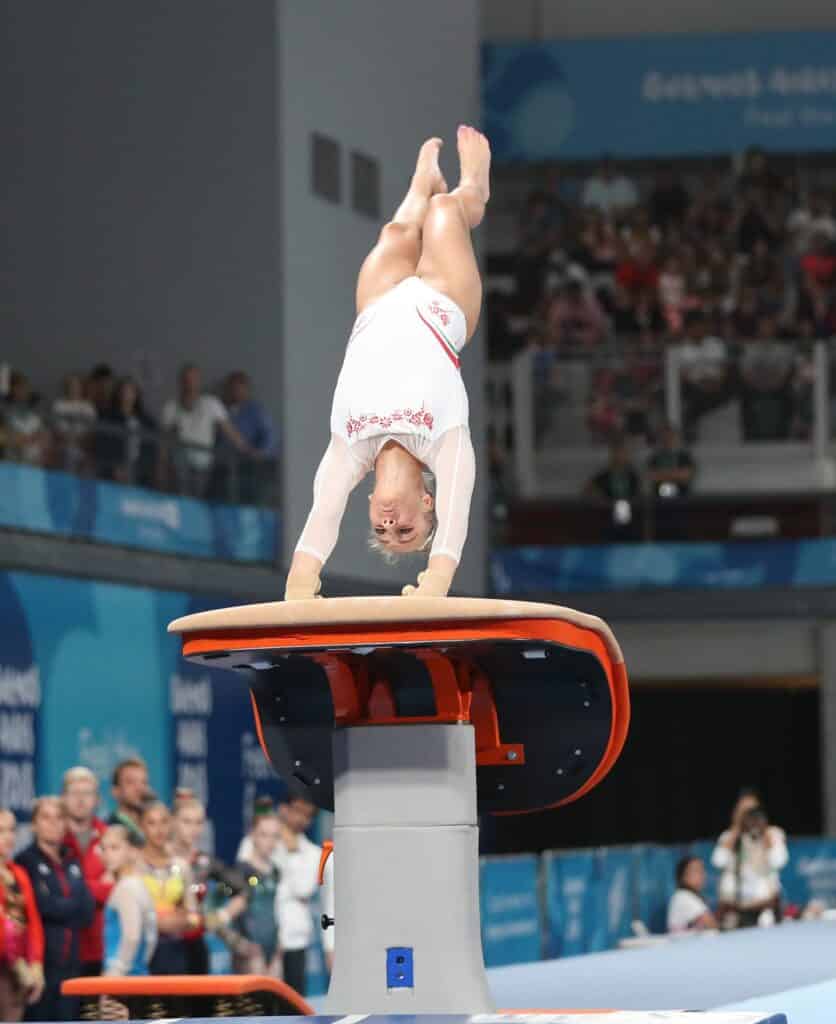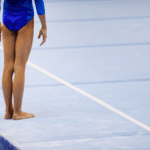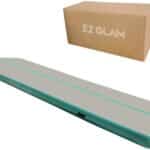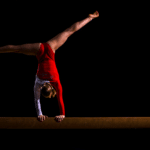Vault gymnastics skills are used in both Men’s and Women’s Artistic gymnastics. A lot of beginner gymnasts will therefore be taught Vault to help them develop their gymnastics skills.
The gymnastics Vault can be a scary piece of apparatus because it is big and high and it’s easy to fall with only the slightest of mistakes.
In this article, I explain 8 basic gymnastics vault skills that beginner gymnasts need to master if they want to be successful, especially at a competitive level.
Let’s jump into this!

Disclaimer: Gymnastics carries an inherent level of risk. Information contained in this article does not replace the need for professional coaching in a recognized gymnastics facility.
Introduction to Vault Gymnastics Skills
Before learning any of these 8 Vault skills a gymnast must have already learned how to use the springboard and land safely. As with all gymnastics skills, each vault can be broken down and learned in small chunks rather than attempting to do the whole thing in one go the first time.
For example, coaches will use lower vaults or stacks of softer mats to land on. A gymnast will also need to be familiar with basic gymnastics shapes such as tuck and stretched shapes before learning how to vault.
A good professional coach will also physically spot a gymnast in case something goes wrong. For that reason, it is always safer to learn how to vault in a professional gymnastics facility.
Table of Contents
- Introduction to Vault Gymnastics Skills
- Squat On Vault
- Through Vault
- Straddle On Vault
- Straddle Over Vault
- Handspring Vault
- Round Off Vault (Half on)
- Half on Half Off Vault
- Half on Full Off Vault
- Conclusion
Squat On Vault
A Squat on Vault is the first basic Vault move that I teach beginner gymnasts.
A gymnast will need to reach forwards with their arms as they jump.
After take-off, the legs will need to come up into a tuck shape and the feet should land on the top of the Vault. This is when we should see the Squat Shape (it looks like a crouch shape). It’s common to see beginner gymnasts land on their knees which is something they need to correct.
The feet and knees should be together and land in between the hands. At this point, the gymnast should stop moving and make sure they are on balance. They can then stand up into a stretched shape and jump from the Vault onto the landing mat.
Any type of jump can be performed – Stretched, Tuck or Star jumps are the ones we usually start with.

Through Vault
Many people ask ‘What is a Through Vault in gymnastics?’
A Through Vault is very similar to a Squat On Vault except the gymnast doesn’t stop on top of the Vault. Instead, they pass through the Squat shape and have the feet land directly on the landing mat.
The key to being able to master this Vault is pushing off the Vault with the hands. This will create an extra push to get over the vault and help the gymnast lift the chest ready to land.
Straddle On Vault
The Straddle on Vault is very similar to the Squat On Vault. The gymnast needs to land and stop on top of the Vault but in a Standing Straddle shape rather than a squat shape.
Standing Straddle is feet apart (slightly more than shoulder-width) with hands in the middle of the feet. Legs should be straight and knees pushed back. Once a gymnast lands in the Straddle position, they stand up and slide their feet together into a stretched shape. They can then jump off the Vault to the landing mat.
The Straddle on Vault is harder to perform on modern Table-shaped Vaults as they are narrower compared to the old-style wide vaults of the 1970s and 1980s.
Straddle Over Vault
Once a gymnast has mastered the Straddle On they can develop this into a Straddle Over by not stopping on top of the Vault.
Legs should stay straight and toes pointed as they pass over and around the Vault.
The arms should push off the Vault quickly to help lift the chest and land. Many gymnasts find this difficult as it is a scary Vault to learn but it results in them leaving their hands behind on the Vault, dropping the head and chest and making it hard to land on the feet.
Handspring Vault
The Handspring Vault and the remaining Vaults listed in this article begin to step up a difficulty level. Although I class them as beginner Vaults they will still take many months to learn and gymnasts will need to do regular strength and conditioning to prepare their body.
The Handspring Vault is often the first Vault a gymnast will perform where they become inverted (go upside down). A high stack of mats is often used so that the gymnast can start learning the handspring by landing on their back.
Because the Handspring Vault is a building block to more advanced Vaults, it is vital that good technique is learned from early on.
To perform a Handspring Vault, the gymnast takes off facing forward and passes through a Handstand shape when the hands contact the Vault. In more advanced versions of the Handspring, somersaults and twists are added before landing. however, a basic Handspring Vault simply lands on its feet after passing through Handstand.
Round Off Vault (Half on)
The Round Off Vault belongs to the Tsukahara family of Vaults. The simplest way to describe a Round Off Vault is by performing a Handspring but adding a Half Turn before the hands contact the Vault.
This means the gymnast faces backward as they contact the Vault. For more advanced gymnasts they can then add somersaults, but a basic Half On will simply land on the feet after contacting the Vault.
Half on Half Off Vault
Once the Half On has been mastered, a gymnast can add another Half Turn after they contact the Vault. This will complete the Half On Half Off Vault.
A gymnast will need to have a good level of conditioning and understand the concept of twisting to be able to learn the Half on Half Off Vault.
Half on Full Off Vault
As the name suggests, the gymnast will need to complete a full 360-degree twist after contacting the Vault.
Most gymnasts will first learn the Half On Half Off and then add an extra 180-degree twist. They can even begin by doing the final Half Turn Jump after they land. The body should stay straight and extended throughout the whole Vault.
Conclusion
Gymnastics Vault skills require a lot of mental strength to overcome the fear of jumping and landing safely. A gymnast should build their confidence by slowly adding difficulty and progressing one step at a time.
The variations of Vault moves are huge and if you want to read more about the history of Vault check out my complete guide to the Vault here. You can also read about more advanced Vault moves including The Yurchenko.
Latest Articles
- 19 Fun Trampoline Games for Kids
 Are you looking for fun Trampoline Games to keep your kids entertained? Whether you’re hosting a birthday party, a family gathering, or simply looking for… Read more: 19 Fun Trampoline Games for Kids
Are you looking for fun Trampoline Games to keep your kids entertained? Whether you’re hosting a birthday party, a family gathering, or simply looking for… Read more: 19 Fun Trampoline Games for Kids - Gymnastics Flexibility: The Keys to Success
 Flexibility, sometimes overshadowed by strength and power, is a vital element of gymnastics training. It’s the silent hero that allows gymnasts to glide through air… Read more: Gymnastics Flexibility: The Keys to Success
Flexibility, sometimes overshadowed by strength and power, is a vital element of gymnastics training. It’s the silent hero that allows gymnasts to glide through air… Read more: Gymnastics Flexibility: The Keys to Success - What is a Full-In in Gymnastics?
 One of the most challenging moves in gymnastics is the Full-in. The Full-in is a skill competed on a range of apparatus in Artistic as… Read more: What is a Full-In in Gymnastics?
One of the most challenging moves in gymnastics is the Full-in. The Full-in is a skill competed on a range of apparatus in Artistic as… Read more: What is a Full-In in Gymnastics? - 11 Ways To Use Your Gymnastics Air Track
 Discover 11 amazing things you can do on a gymnastics air track and take your skills to the next level! From perfecting your cartwheel to… Read more: 11 Ways To Use Your Gymnastics Air Track
Discover 11 amazing things you can do on a gymnastics air track and take your skills to the next level! From perfecting your cartwheel to… Read more: 11 Ways To Use Your Gymnastics Air Track - Essential Gymnastics Bar Exercises (for beginners)
 Gymnastics is a sport that requires strength, flexibility, and control, and the bar is one of the most important pieces of equipment used to train… Read more: Essential Gymnastics Bar Exercises (for beginners)
Gymnastics is a sport that requires strength, flexibility, and control, and the bar is one of the most important pieces of equipment used to train… Read more: Essential Gymnastics Bar Exercises (for beginners) - Balance Beam Skills for Beginners
 If you are just starting out in gymnastics you may be wondering what the ideal Balance Beam skills for beginners are. I have put together… Read more: Balance Beam Skills for Beginners
If you are just starting out in gymnastics you may be wondering what the ideal Balance Beam skills for beginners are. I have put together… Read more: Balance Beam Skills for Beginners
